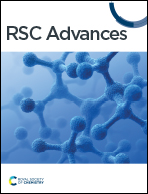A phenothiazine-functionalized pyridine-based AIEE-active molecule: a versatile molecular probe for highly sensitive detection of hypochlorite and picric acid†
Abstract
In this study, we designed and synthesized a novel compound (PTH-AB-PY) based on phenothiazine and pyridine moieties with aggregation-induced emission enhancement (AIEE) properties. The compound has shown exceptional selectivity and sensitivity towards ClO− ions with an impressive detection limit of 6.86 × 10−4 M. Its remarkable sensitivity arises from its effective inhibition of the photoinduced electron transfer (PET) mechanism. Job's plot analysis and high-resolution mass spectrometry (HR-MS) confirmed the 1 : 1 binding ratio between the compound and ClO−. The synthesized compound also exhibits higher sensitivity and fluorescence quenching towards the explosive species (picric acid), with a detection limit of around 1.44 × 10−6 M. Furthermore, our work was carried out for real-time water sample analysis to check ClO− and picric acid detection and high recovery rates (94 to 99%) were achieved. These findings highlight the potential of PTH-AB-PY as a promising molecular probe for ClO− ions and picric acid detection with various analytical and environmental applications.



 Please wait while we load your content...
Please wait while we load your content...